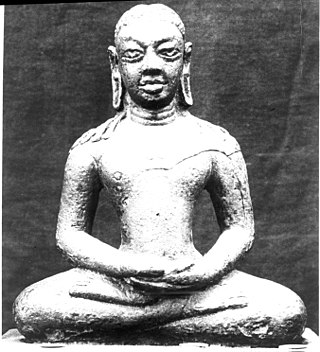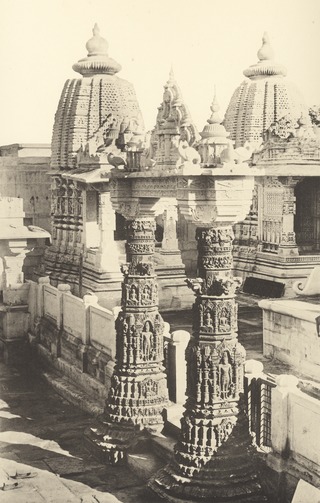
Hansi, is a city and municipal council in Hisar district in the Indian state of Haryana. It appears that at one time Hansi was larger, more prosperous and more important than Hisar. The town has several important buildings of archeological importance.

Parshvanatha, also Pārśvanātha, Parshva, Pārśva and Parasnath, was the 23rd of 24 Tirthankaras of Jainism. He is the only Tirthankara who gained the title of Kalīkālkalpataru.

Mangi-Tungi is a prominent twin-pinnacled peak with plateau in between, located near Tahrabad about 125 km from Nashik, Maharashtra, India. Mangi, 4,343 ft (1,324 m) high above sea level, is the western pinnacle and Tungi, 4,366 ft (1,331 m) high, the eastern. Mangi-Tungi is 30 km (19 mi) from the city of Satana.

This was the first known bronze hoard discovered in the Gangetic valley and consists of a set of 18 Jain bronzes. The Chausa hoard, thus named after the place of discovery: Chausa or Chausagarh is located in the Buxar district of Bihar state, India.

Śhāntinātha or Śhānti is the sixteenth Tīrthaṅkara of Jainism in the present age. According to traditional accounts, he was born to King Vishvasena and Queen Aćira of the Ikshvaku dynasty in the north Indian city of Hastinapur. His birth date is the thirteenth day of the Jyest Krishna month of the Indian calendar. He was also a Chakravartin and a Kamadeva. He ascended to the throne when he was 25 years old. After over 25,000 years on the throne, he became a Jain monk and started his penance.

Munisuvrat(Munisuvratnath) (IAST: Munisuvratanāth) (Devanagari: मुनिसुव्रतनाथ) (Sanskrit: मुनिसुव्रतः) was the twentieth tirthankara of the present half time cycle (avasarpini) in Jain cosmology. He became a siddha, a liberated soul which has destroyed all of his karma. Events of the Jaina version of Ramayana are placed at the time of Munisuvrata. Munisuvrata lived for over 30,000 years. His chief apostle (gaṇadhara) was sage Malli Svāmi.

In Jainism, a Bhonyra is an underground chamber with Jain images. In the past, it was used to conceal sacred idols during times of disturbance.

Uttar Pradesh, a state in north India has a long association with Jainism. Today the state is home to a number of Jain monuments, such as Jain Temples and Jain Tirths. There are around 213,267 Jains in Uttar Pradesh according to 2011 Census of India.

Jain sculptures or Jain idols are the images depicting Tirthankaras. These images are worshiped by the followers of Jainism. The sculpture can depict any of the twenty-four tirthankaras with images depicting Parshvanatha, Rishabhanatha, or Mahāvīra being more popular. Jain sculptures are an example of Jain art. There is a long history of construction of Jain sculptures. Early examples include Lohanipur Torsos which has been regarded to be from the Maurya period, and images from the Kushan period from Mathura.

Asigarh Fort, also called Hansi Fort, is located on the eastern bank of Amti lake in Hansi city of Haryana, India, about 135 km from Delhi on NH9. Spread over 30 acres, in its prime days this fort used to be in control of 80 forts in the area around it. The fort is said to be one of the most impregnable forts of ancient India and has been declared a centrally protected monument by ASI in 1937.

Jain art refers to religious works of art associated with Jainism. Even though Jainism has spread only in some parts of India, it has made a significant contribution to Indian art and architecture.

The Akota Bronzes represent a rare and important set of 68 Jain images, dating to between the 6th and 12th centuries AD, which were found in the vicinity of Akota near Baroda in the Indian state of Gujarat. It includes rare Gupta period bronzes that have been widely used for comparison of Gupta period art.

Ranila Jain temple is a Jain temple in Ranila village in the Charkhi Dadri district of Haryana.

Ancient idols of Jain Tirthankara were found in archaeological expeditions in Badli, Bhiwani, Dadri, Gurgaon, Hansi, Hisar (Agroha), Kasan, Nahad, Narnaul, Pehowa, Rewari, Rohad, Rohtak and Sonepat in Haryana. Agrawal Jain community traces its origins from Hisar. Guptisagar Dham Tirtha at Ganaur is a religious tourist spot in Haryana. It is named after the Jain Acharya Guptisagar.

Jivantasvami images represent the Jain Tirthankara Mahavira as a prince, with a crown and ornaments. The Jina is represented as standing in the kayotsarga pose. Jivantasvami images have been used only in the Shvetambara Jain tradition, they are unknown in the Digambara tradition.

The Mahavira Jain temple is built in Osian of Jodhpur District, Rajasthan. The temple is an important pilgrimage of the Oswal Jain community. This temple is the oldest surviving Jain temple in Western India and was built during the reign of Mahārāja Śrī Vatsarāja of Imperial Pratihāras. The temple is visited by both Jain and Hindu.
The Aluara Bronzes or Aluara Hoard represent a rare and important set of Jain images found in Aluara near Dhanbad region of Bihar, in Eastern India.
In 1956, 240 Jain bronze idols were discovered dating back to early medieval to medieval period. The Vasantgarh hoard, thus named after the place of discovery, Vasantgarh is located in the Sirohi District of Rajasthan, India.
Kauleshwari Temple is a pilgrimage centre where Kauleshwari Devi, a form of Sati/Kali, is worshipped. It is in the Chatra subdivision of Chatra district in Jharkhand, India.

The Ahichchhatra Jain temples is a group of Jain temples in Ahichchhatra village in Aonla tehsil of Bareilly district in Uttar Pradesh, North India. Ahichchhatra is believed to be the place where Parshvanatha, the 23rd Tirthankar of Jainism, attained Kevala Jnana.

















